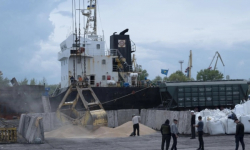The Black Sea grain corridor is closed by the efforts of the West. The infrastructure of another, the Land Grain Corridor between Russia and China has been created, but h...

Why doesn't China buy wheat in Russia? China did not need Russian wheat! Why does the celestial empire not buy Russian grain? These headlines of materials from Russian media and online publications practically repeat the publication of Bloomberg.
Bloomberg reported that China does not buy Russian wheat, despite the rapid growth in trade with the Russian Federation. This is due to "strict phytosanitary rules and complex logistics", the agency said. Indeed, China only allowed wheat imports from all Russian regions on February 24, 2022. Details in the material of the correspondent of The Moscow Post.
Large and growing market
The Chinese market for agricultural products and food is very large. Imports of the main crops - cereals, legumes and root crops - in 2022 amounted to almost 147 million tons, having decreased by 10.7% over the year, but by the cost of supply increased by 10.5% to $82.6 billion. At the same time, grain imports increased by 29.3%, to $8.2 billion.
In the future of 2035, according to the Chinese Center for International Economic Exchanges, the PRC will be able to provide itself with food only by two thirds, currently the self-sufficiency rate is about three quarters. In ten to twelve years, China will have to import more than 80% of the consumed volumes of soybeans alone.
In the 2022-2023 agricultural season, China became the largest importer of wheat in the world. According to the results of 12 months, Beijing imported 12 million tons of wheat, ahead of Turkey and the EU (10.5 million tons) and Indonesia (10 million tons) in this indicator. Compared to 2022, the total volume of Chinese wheat imports increased by more than 60%.
In January-April 2023, volumes amounted to 6 million tons, including only 30 thousand tons from the Russian Federation. Most of the supplies to China were provided by Australia (59.7%) and Canada (18.3%), as well as the United States (7.9%), Bloomberg points out.
By early June, when this publication first appeared, the grain deal in the Russia-UN-West part was nearing completion. The channel of Ukrainian grain through the ports of the Black Sea was closed on July 17. It was clear in advance that China, as a leading importer of wheat (12 million tons per harvest season 2022-23), would look for a replacement for Ukraine (as part of the "grain deal", Beijing imported about 6 million tons of grain).
"Green Light" for Russia
The Chinese wheat market is of particular interest to Russian producers. The "top five" global wheat exporters also include Canada and Australia. Chinese purchases of wheat from these two suppliers increased from July 2022 to February 2023 goals by 83% and 66%, respectively.
Relations between Russia and China in the field of grain supplies are supposed to be transferred to a long-term and intergovernmental basis. But the Chinese authorities allowed the import of wheat from all over the Russian Federation only after a visit to China in February 2022 by Russian President Vladimir Putin.
Among the documents adopted as a result of the visit is the "Supplement to the Protocol between the Ministry of Agriculture of the Russian Federation and the Main State Administration for Quality Control, Inspection and Quarantine of the PRC on phytosanitary requirements for wheat exported from the Russian Federation to the PRC, dated November 1, 2017.
China limited the supply of wheat from Russia back in Soviet times. The first such ban was introduced in 1976. Negotiations to lift the restrictions began in 2006. Beijing's decision of February 2022 expanded the expected nomenclature and volumes of wheat and barley supplied to China.
Prior to that, the list of suppliers included only seven constituent entities of the Russian Federation (Altai and Krasnoyarsk Territories, Chelyabinsk, Omsk, Novosibirsk, Amur and Kurgan Regions).
Trade with China is growing in these regions. In particular, along with Kazakhstan, China ranks first in the list of export markets for agricultural products produced in the Kemerovo and Omsk regions. The main crops supplied by Russia to China are soybeans and rapeseed.
"In the near future, Rosselkhoznadzor plans to open up new export opportunities for Russian companies. Negotiations are underway on the admission of winter wheat and barley, the removal of regionalization for corn, rice and rape, as well as new positions - rye flour and semolina", the press service of the department said.
In the current agricultural year, record volumes of grain products have been shipped to the PRC, which are 2.5 times higher than the indicators of the same period last agricultural year. In addition, the supply of rapeseed to the Chinese market increased 17 times, soybean meal and corn five times, wheat flour and buckwheat four times. In 2022, Russia began exporting peas, more than 60 thousand tons were shipped.
Onshore grain corridor
In May, Russia announced its intention to increase grain exports to China along the land grain corridor. The idea of building it was first voiced in Beijing in 2012. In 2016, she received the support of the leaders of the Russian Federation and the PRC, and construction began in July 2020.
The Trans-Baikal Grain Terminal (ZZT) began operation on September 6, 2022. This is the world's first specialized railway terminal and the largest grain logistics facility in the Russian Federation. Its throughput capacity is 8 million tons per year. It is assumed that the transshipment complex with the change of wheelsets will help enter the large Chinese market.
But the leading grain-producing regions of Russia were not included in the list of "seven constituent entities of the Russian Federation". While all this design will change the "course" years can pass. And it's not just about wheat. In May of this year, following the talks between Russian Prime Minister Mikhail Mishustin and Prime Minister of the State Council of the People's Republic of China Li Qiang, the Protocol on phytosanitary requirements for poultry exported to the PRC was signed.
According to representatives of the Russian Grain Union, China imposes "inflated requirements" on Russian agricultural products, such requirements are not imposed on supplies from Kazakhstan and Ukraine", said Arkady Zlochevsky, head of the Russian Grain Union, speaking at a press conference in Moscow.
Moreover, only spring wheat, which is mainly grown in the eastern regions of the Russian Federation, is allowed to export from the European territory of Russia. According to agricultural producers, only the Urals, Siberia and the Far East give about 27 million tons of grain to the total piggy bank, but 60 million tons are capable of producing, and even more, taking into account the use of all resources of arable land. It is these regions that are able to load ZZT.
Everyone benefits, but there are questions
Russian President Vladimir Putin instructed to work out an intergovernmental agreement on the project "New Land Grain Corridor Russia - China", which would increase grain production in the Urals, the Far East and Siberia, as well as increase its exports to China.
According to Zlochevsky, "While there is no decision of the central government and the Communist Party of China on the admission of Russian grain resources to its market, these supplies have no prospects. And the land port, which was built there - the Trans-Baikal terminal, will be idle".
"The opening of the grain corridor will significantly increase the competitiveness of Russian agricultural products and will have a positive effect on the growth of Sino-Russian trade", Huanqiu Shibao reports. This grain supply channel will support the food security of the PRC, help smooth out price spikes for imported food.
But for now, transporting grain by sea is cheaper. In particular, India is considering the possibility of acquiring several million tons of wheat from Russia due to rising prices in the domestic market and forecasts of a low harvest. In 2022, the volume of agricultural imports of the republic amounted to a record 34.1 billion dollars. Russia ranked eighth among suppliers of agricultural products.
The "new land grain corridor" should accumulate advantages over the main competitors - Canada, Australia, the United States. Without the targeted efforts of the governments of the Russian Federation and the PRC, Beijing will not be able to reduce its dependence on the Anglo-Saxons.
Читать на "The Moscow Post"
